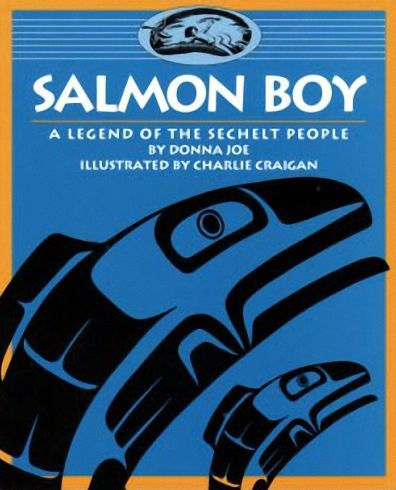

Paperback
-
PICK UP IN STORECheck Availability at Nearby Stores
Available within 2 business hours
Related collections and offers
Overview
Simple and compelling First Nations drawings illustrate this dynamic story that teaches respect for the environment and describes the life cycle of the salmon.

Product Details
| ISBN-13: | 9780889711662 |
|---|---|
| Publisher: | Nightwood Editions |
| Publication date: | 09/21/2001 |
| Series: | Legends of the Sechelt Nation Series , #3 |
| Pages: | 24 |
| Product dimensions: | 6.70(w) x 8.30(h) x 0.10(d) |
| Age Range: | 4 - 9 Years |
About the Author
Charlie Craigan was born in Sechelt in 1969. His natural artistic talent began showing itself when he was still a Grade 5 student at Sechelt Elementary and was further developed while working with local carvers Arnold Jones and Jamie Jeffries. He is a member of the Sechelt Indian Band and resides in Sechelt.
Read an Excerpt
Excerpt:Long, long ago, a boy lived in a village called Kalpilin, the winter home of the Sechelt Nation. The boy's people lived in great longhouses along the seashore. It was a good place to live but the people often went hungry during the long winter months. In those days so long ago the salmon did not fill the creeks and rivers of Sechelt.One beautiful summer day, the boy decided to escape the heat by going for a swim in the sea beside kalpilin. As he swam out from the shore, a giant chum salmon seized him and pulled him down under the sea to the country of the salmon people.Although the country of the salmon people was beneath the sea, it was dry and the salmon people walked about the same as people do above the sea. Everyone lived in cedar plank houses and all along the beach their canoes were lined up in a row.The giant chum salmon took the boy to his home and made him a slave. The boy was fascinated by these very special people and took careful note of everything they did.Some women made cedar root baskets and hats. Others made shredded cedar bark capes, skirts and mats. Some men carved house poles, welcome poles, feast bowls and dugout canoes from the wood of the cedar.In the winter, when the work of the summer was done and the longhouses were full of the salmon they had dried and smoked, they celebrated with singing and dancing for weeks at a time. Each house had its own singers and dancers. This was also the time for storytelling. Their food in winter months was salmon which had been smoked and dried the summer before.THE SECHELT NATIONThe Sechelt Nation, a division of the Coast Salish family of First Nations peoples, originally occupied the southern portion of what is now known as the Sunshine Coast, from Gower Point near Gibsons to Saltery Bay, south of Powell River. At time of contact the shishalh (Sechelt people) occupied some 80 scattered village sites divided into four main tribal groupings, the xenichen, the t'sunay, the tuwankw and the sxixus. A populous and peaceful people, the Sechelt enjoyed a comparatively prosperous existence owing to their benign climate and an abundance of salmon, herring, and other food resources. Estimates of original population range from 5,000 to 20,000, but by the time of the first official census in 1881, Sechelt population had plunged to a mere 167, mostly as a result of introduced diseases.Father Paul Durieu of the Oblate missionaries converted the Sechelt to Catholicism by 1865 and founded a central mission at the present Sechelt village on Trail Bay in 1868. The modern Sechelt are one of Canada's most progressive First Nations groups, having been involved in the operation of a deep-sea fishing vessel, a commercial airline, a salmon hatchery, an office and cultural complex, a large gravel-mining project, and other business enterprises. In 1986 the Sechelt gained international notice when their long campaign to gain control of their own affairs culminated in the successful passage of Bill C-93, The Sechelt Indian Band Self-Government Act, making them the first band in Canada to achieve native self-government. In 1999, the band followed this by signing an agreement in principle for settling its land claim with federal and provincial governments. As of 1999, the Sechelt band numbered 1003 members, 448 of whom lived on band lands.
